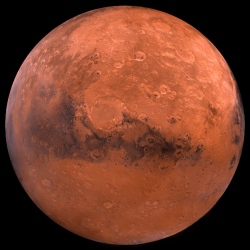
On Wednesday, Elon Musk’s private company SpaceX announced on Twitter that it plans to send a spacecraft to Mars as soon as 2018. The mission will involve sending a spacecraft called the Red Dragon to Mars to retrieve samples collected by NASA’s Mars rover and then return them to Earth.
SpaceX has had big plans to usher in a new era of reusable rockets that could send the first humans to Mars and return them home for a while. On December 21, 2015, SpaceX successfully landed its first reusable rocket, a Falcon 9, on a launch pad. They followed that up on April 8, 2016 by successfully landing another Falcon 9 on a barge floating in the ocean. Musk has announced plans to relaunch this Falcon 9 as early as May.
The Red Dragon will be launched into space with the Falcon Heavy rocket, which is kind of like the Falcon 9 on steroids. SpaceX has announced plans to launch the rocket into space as soon as November 2016.
SpaceX has boasted that the Falcon Heavy is the world’s most powerful rocket, capable of carrying twice the payload of the Space Shuttle. Only the Saturn V, the rocket used to launch astronauts to the moon in the Apollo program, was capable of delivering more payload to orbit.
The Falcon Heavy is a multistage rocket, which means it contains separate rockets, or stages, stacked on top of each other. Each stage contains its own engine and propellant. When a stage runs out of propellant, it is ejected from the spacecraft to decrease the remaining mass of the rocket.
Musk confirmed on Twitter on Friday, April 29 that SpaceX will be attempting to land all three booster stages during the Falcon Heavy launch. Judging from the illustrations on their Flickr account, SpaceX plans to land on Mars using a simple approach that’s never been tried before.
The unmanned Dragon capsule has been making trips to the International Space Station since 2010. But to get to Mars, which is 560,000 times farther, the Dragon will need to ride a more powerful rocket than the Falcon 9, which it takes to the ISS.
That rocket is SpaceX’s Falcon Heavy, illustrated below, that is scheduled to launch out of Kennedy Space Center for the first time next year. However, this monster rocket will only take Dragon so far. Getting to Mars is easy compared to landing on it because the Martian atmosphere is a tricky beast to control.
The Martian atmosphere is about 1,000 times thinner than Earth’s, so simple parachutes won’t slow a vehicle down enough to land safely. But that atmosphere is still thick enough to generate a great deal of heat from friction against a spacecraft.Therefore, to land on Mars you have to have a spacecraft with a heat shield that can withstand temperature of 1600 degrees Fahrenheit.
Luckily, Dragon’s heat shield can protect it against temperatures of over 3,000 degrees Fahrenheit, so plummeting toward Mars, illustrated below, shouldn’t be a problem heat-wise.
But there’s still the problem of slowing down. Although gravity on Mars is about 1/3 of what it is on Earth, the vehicle is still plummeting toward the ground at over 1,000 miles per hour after entering Mars’s atmosphere. If it were to hit the ground at those speeds, you’d have a disaster.
The way that SpaceX aims to deal with this tricky problem is to use the thrusters on board the Dragon spacecraft to first redirect its momentum from downward to sideways, as illustrated below, thus reducing its speed:
The last major Mars landing was NASA’s Curiosity rover in 2012. This landing was a huge success but extremely complicated that involved half a dozen steps that, if not completed perfectly, would end in disaster. NASA dubbed the landing process “7 minutes of terror” because that’s how long it took to enter the atmosphere and land.
But the technology isn’t ready for human passengers just yet. Musk tweeted that the Dragon might not be the most comfortable environment for space explorers.
This mission marks an important milestone in the partnership between NASA and SpaceX, bringing them one step closer to achieving their goal of sending humans to Mars in by the 2030s.
